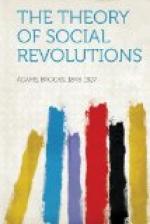kind of property, and sufferers brought their cases
before the courts to have the constitutionality of
the acts tested, under the provisions which existed
in all state constitutions, forbidding the taking,
by the public, of private property without compensation,
or without due process of law. Such a provision
existed hi the constitution of the State of New York,
adopted in 1846, and it was to invoke the protection
of this clause that one Wynehamer, who had been indicted
in 1855, carried his case to the Court of Appeals
in the year 1856. In that cause Mr. Justice Comstock,
who was one of the ablest jurists New York ever produced,
gave an opinion which is a model of judicial’
reasoning. He showed conclusively the absurdity
of constitutional restrictions, if due process of law
may be held to mean the enactment of the very statute
drawn to work confiscation.[23] This decision, which
represented the profoundest convictions of men of
the calibre of Comstock and Denio, deserves to rank
with Marshall’s effort in the Dartmouth College
Case. In both instances the tribunal exerted
itself to carry out Hamilton’s principle of
judicial duty by exercising its judgment and
not its will. In other words, the judges
propounded a general rule and then simply determined
whether the set of facts presented to them fell within
that rule. They resolutely declined to legislate
by entering upon a consideration of the soundness
or reasonableness of the policy which underlay the
action of the legislature. In the one case as
in the other the effort was unavailing, as Jefferson
prophesied that it would be. I have told of Marshall’s
overthrow in the Charles River Bridge Case, and in
1887, after controversies of this category had begun
to come before the Supreme Court of the United States
under the Fourteenth Amendment, Mr. Justice Harlan
swept Mr. Justice Comstock aside by quietly ignoring
an argument which was unanswerable.[24] The same series
of phenomena have appeared in regard to laws confiscating
property invested in lotteries, when opinion turned
against lotteries, or in occupations supposed to be
unsanitary, as in the celebrated case of the taxing
out of existence of the rendering establishment which
had been erected as a public benefit to relieve the
City of Chicago of its offal.[25] In fine, whenever
pressure has reached a given intensity, on one pretext
or another, courts have enforced or dispensed with
constitutional limitations with quite as much facility
as have legislatures, and for the same reasons.
The only difference has been that the pressure which
has operated most directly upon courts has not always
been the pressure which has swayed legislatures, though
sometimes both influences have combined. For
example, during the Civil War, the courts sanctioned
everything the popular majority demanded under the
pretext of the War Power, as in peace they have sanctioned
confiscations for certain popular purposes, under
the name of the Police Power. But then, courts
have always been sensitive to financial influences,
and if they have been flexible in permitting popular
confiscation when the path of least resistance has
lain that way, they have gone quite as far in the
reverse direction when the amount of capital threatened
has been large enough to be with them a countervailing
force.




